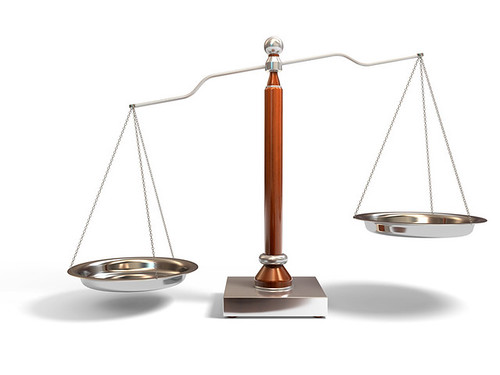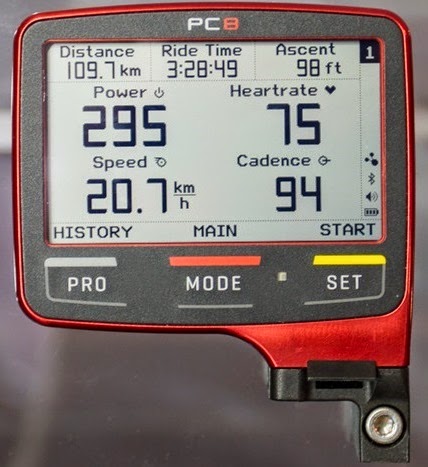One of the more recent features to emerge with on bike power meters has been the reporting of something called "Power Balance". It's meant to provide an indicator of the split in power production between your left and right legs - an indicator of asymmetry in power output. It's a pretty simplistic indicator of what's going on with pedalling forces, and masks over much detail. It's also not all that clear whether it's of much value.
 |
| How's your power balance? |
So if your Power Balance is reporting as 46%-54%, then it's reasonable to assume that means 46% of the total power output is coming from your left leg and 54% from your right leg. Except that maybe it's not.
So then, what is it really measuring?
Is it important/useful?
And is the L-R power balance data accurate?
What is Power Balance actually measuring?
You see, while some of the more popular ANT+ power meters are each reporting a power balance number, there isn't a standard as to what power balance actually means, and these meters are not reporting the same thing.
There are two main types of power balance data reported (there's actually more but I'm going to leave those others out for now), and which of these a power meter reports depends on where and how the forces are measured. I've decided to give each a name, it's possible others have already done the same and used a different name and quite possibly there are better ways to distinguish between each type. It's also possible I'm wrong with some details, and I'll be (happily) corrected if that's the case.
The issue comes about primarily because different power meters measure the forces at different points along the drivetrain, somewhere along the transmission from the pedals to the rear tyre. The dividing line is whether the measurement is done upstream or downstream of the spindle or bottom bracket connecting the left and ride side crank arms. Upstream means measurement of the forces applied to each crank arm, or to each pedal (or even cleats or shoes), and downstream means measurement of the forces applied to the crank spider, or chainrings, chain, rear cogs, rear hub, wheel or tyre.
You see, the downstream measurement locations cannot distinguish from which crank arm the force is being applied, whereas measurement done upstream on each crank arm or at each pedal can make that distinction (but they must measure both sides independently to do that). Downstream measurement of power balance is therefore split based on a crank's rotational location whereas upstream measurement of power balance is based on which side of the bike the forces have been applied.
1. Downstream power balance
This version of power balance is calculated from the power applied during the time when one or the other crankarm is forward of the bottom bracket, irrespective of which leg or crank arm is applying the forces. In other words, the left side power balance is the net contribution to power from both legs while the left hand side crank arm is forward of the bottom bracket, expressed as a percentage of the total power. Right side power balance of course must then be the same for when the right crank arm is forward of the bottom bracket.
This is the power balance values the Quarq and Power2Max reports, and also what the Computrainer, Wattbike and SRM systems report via their own data systems.
2. Upstream power balance
This version of power balance is calculated from the power applied to either crank arm for the entire pedal stroke. This version of left side power balance is then the net power applied by the left leg only to the left crank arm for the entire pedal stroke. And of course the same applies to the right side.
This is what Garmin Vector, MEP, Axis Cranks etc report.
1. and 2. are not therefore, measuring the same thing, and nor is one necessarily better than the other in its current simplistic guise.
As an excellent demonstration of the differences, Ray on his DC Rainmaker blog did a test showing the live power balance numbers reported from a Quarq (a downstream device) and the Garmin Vectors (an upstream device). Here's a link to the youtube video:
http://www.youtube.com/watch?v=k0i_jV9ygLI
It's quite obvious how much difference exists between these two versions of power balance. That also assumes of course that each was accurately reporting their version of left and right side data. I'll get to that later.
There is a little more to understand with these data, for instance because the cranks are a connected system, then what happens on one side is affected by what's going on with the other. So while we may see net torque and power reported from each each side (be it the upstream of downstream version of power balance), it is still masking what's actually going on. As yet, data streams with sufficient frequency are not available via ANT+ since it's constrained by transmission of data packets at 4Hz. To do that requires alternative means, which is what SRM's torque analysis, Wattbike and some other solutions provide.
Is power balance data important/useful?
In short, we really don't know. I think there will be times when such data may prove to be somewhat helpful, perhaps in assessing things like bike fits, but one needs to be careful with any assumption that achieving symmetry is the objective. It's not. Better performance is the objective.
And then we also need to learn how to interpret the difference between upstream and downstream power balance data.
So let me start by stating something already very well established in scientific study of pedalling.
Asymmetry in power production is normal and everyone will have a different L-R power balance. It's also well established that asymmetry is also variable and will vary with:
- power output, absolute and/or relative
- cadence (or torque)
- fatigue
- and likely a few other factors such as bicycle position, seated v standing and so on
Asymmetry in bicycle ergometer pedalling
The influence of pedaling rate on bilateral asymmetry in cycling
Bilateral pedaling asymmetry during a simulated 40-km cycling time-trial
On the bilateral asymmetry during running and cycling - a review considering leg preference
Assessment of bilateral asymmetry in cycling using a commercial instrumented crank system and instrumented pedals
Age-Related Differences in Bilateral Asymmetry in Cycling Performance
Analysis of the pedaling biomechanics of master’s cyclists: A preliminary study
Interlimb asymmetry in persons with and without an anterior cruciate ligament deficiency during stationary cycling
External work bilateral symmetry during incremental cycling exercise
There are others that go back to the 1970s but quick link abstracts are not available. This is not a scientific review, but you get the idea.
So, for instance, it's pretty common to see a different power balance at different power outputs as well as at the same power output but at different times during a ride.
So now that you have a power balance number and a trace of how that balance varies during your rides, what now? I mean we all have such asymmetries, some of us more than others, and yet it doesn't always appear to be a significant impediment to performance improvement, certainly not in my own case of a sizeable acquired pedalling asymmetry as shown in this item, but perhaps I'm the exception and not the rule.
Some asymmetries we might be able to address, and some we might not. Of those that we can, should we be concerned with them? Like I said, I'll leave that question open for others to address but it is my view that we should really only be concerned with those that will demonstrably lead to an improvement in performance, and I'd consider a reduction in potenital for injuries as an improvement (not that I am in any way implying there's an established causal link between power asymmetry and injury).
So far we really have no strong evidence either way to know whether this infomation provides us with any actionable intelligence. And so we progress instead with anecdote, personal experience and experimentation, belief, and all the biases and lack of controls that go with it. Anecdata if you will. Over time I'm sure better information will arise as more research is conducted into pedalling biomechanics.
For now, I'd put power balance data into the category of a curiosity, of limited practical value until some better research is conducted into its use and validity.
Accuracy
Another factor to consider is accuracy of the left-right power data. Don't just assume your shiny new Vectors are accurately reporting power balance or that your Computrainer spin scan data is correct either.
As yet, there really hasn't been much in the way of an assessment of the accuracy of left - right power data, nor for that matter any investigation of the accuracy of many power meter devices in the scientific literature for quite a long time. Please direct me to any if I've missed them.
Downstream power balance data
I would say that the downstream power balance data from a Quarq, Power2Max etc is quite likely to be about as accurate as the total power reported. This is because the same set of strain gauges are used to measure and parse the forces, and all that's required is a means to establish the crank's postion each revolution. Even so, this could use verification, and something as simple as checking the variance in left and right side static torque measurements can provide some decent clues.
Nevertheless, we also know that some ANT+ head units and meters often suffer this tendency to falsely repeat 2-3 seconds of power values when you stop pedalling, and these ghost power readings can readily result in quite sizeable discrepencies in overall power accuracy. Are such false power readings also affecting power balance calculations? If you tend to stop pedalling on one side more than the other, it may well be that such power ghost data is mostly attributed to that one side. I really don't know.
Upstream Power Balance data
The left-right upstream power balance data from a Garmin Vector could well be brilliant or it could conceivably be out by some margin. The other day I saw someone post on Facebook some ride data from their new Vectors. Nearly three hours of solid riding with a 61%-39% L-R power balance, and they were inclined to actually believe it. Knowing the rider, I know his asymmetry is not even close that level.
We already know from DC Rainmaker's blog review the accuracy of the Garmin Vector is affected by how tightly the pedals have been installed. This is summarised in this chart showing how the Vectors Ray was testing reported power relative to other power meters when they were installed into the cranks with different tightness:
 |
| Vector's accuracy as a function of how tightly the pedals are installed into the crank arms. Chart from DC Rainmaker's blog |
Given the total variance in reported power for both pedals can be of the order of around 10% depending on how tightly the pedals were installed, then I can readily imagine a large bias error in reported pedal balance would be very easy to create if each pedal is tightened differently.
Indeed it's quite possible a bias error already exists even if both pedals are installed to specification, simply because you have two separate measurement devices, each with its own error range.
So, even if you consider power balance data is of value, you'll need a means to verify its accuracy, as well as understand the difference between upstream and downstream power balance, lest you make poor decisions about a training or positional intervention.
Never fear, you could always wear a power balance bracelet and solve all your problems.
For those that are not aware, it's a forum custom that pink font indicates sarcasm. Read More......













































